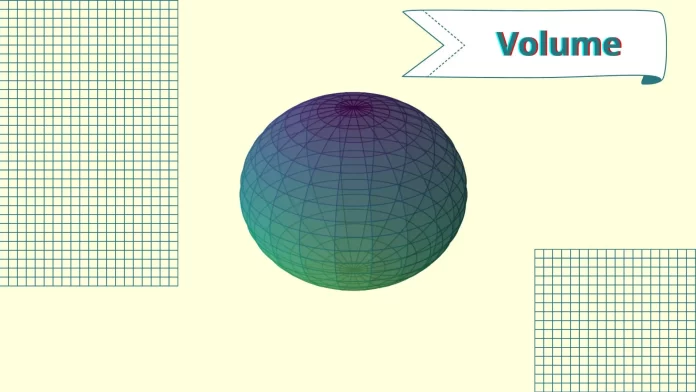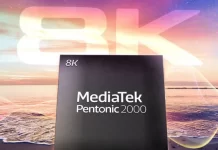That’s important not to confuse color gamut (color space) and color volume. In simple words, while color gamut is the range of colors your TV can reproduce, color volume is the number of colors that can be displayed with different luminosity levels.
Before we deep-dive, consider this: Why does an apple appear red? It’s because it reflects red wavelengths of light while absorbing others. Now, translate this to a TV screen. Your TV must emit light in just the right wavelengths for accurate color representation.
You may have noticed that when the screen’s brightness is low, the number of colors appears low, but the number of colors becomes wider as the brightness increases. But if you set the brightness to maximum, the colors will fade.
That’s because color volume depends on other factors: first of all, that’s color range. But brightness and contrast also play their role.
So the color volume is the derivative of other display parameters. And therefore, the brighter display and the wider its color gamut, the deeper the color volume would be.
Dimensions Involved: It incorporates the range of colors (width x height) and depth (brightness).
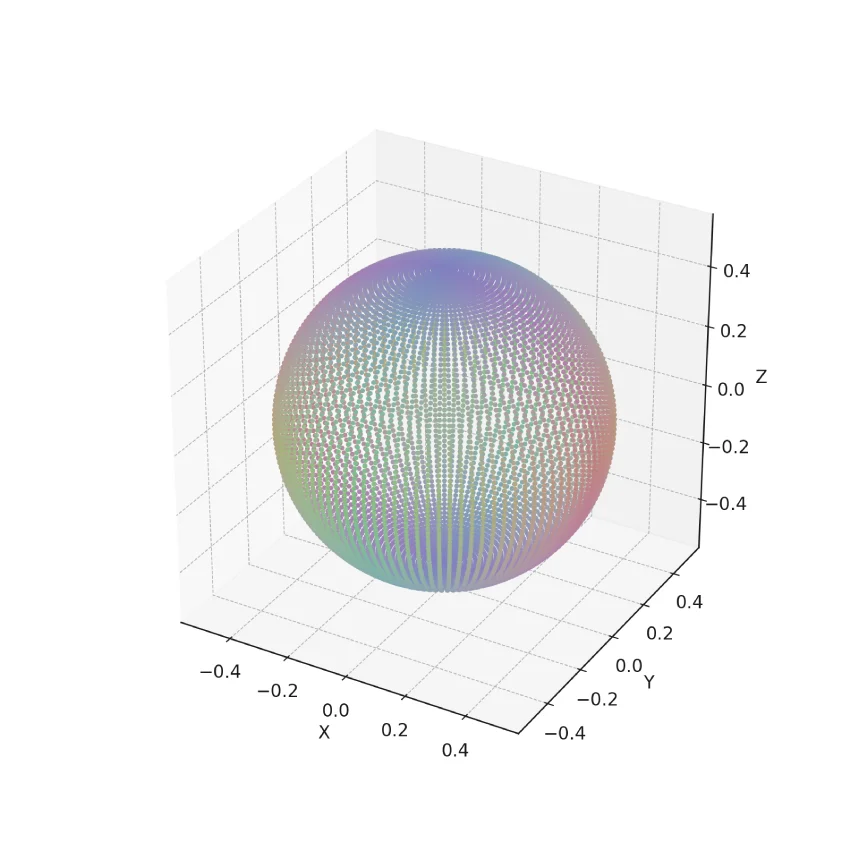
It represents how a TV or display will reproduce colors at varying brightness levels. This is particularly crucial for HDR content which demands precise color accuracy across diverse brightness levels.
Color volume, color gamut, and color depth
Color gamut (or color space) is the range of colors the TV can reproduce. Sometimes it’s defined as the number of colors, but that’s a little bit incorrect, as the color is the spectrum.
The color gamut can be represented as red, green, and blue space. The combinations of these primary colors create the other colors, their shades, tints, and tones.
Let’s take a look at this CIE 1931 color space. It represents colors at their max saturation. Depending on its quality, we can define different spaces that our display can reproduce: Rec.709, sRGB, DCI-P3, and Rec. 2020.
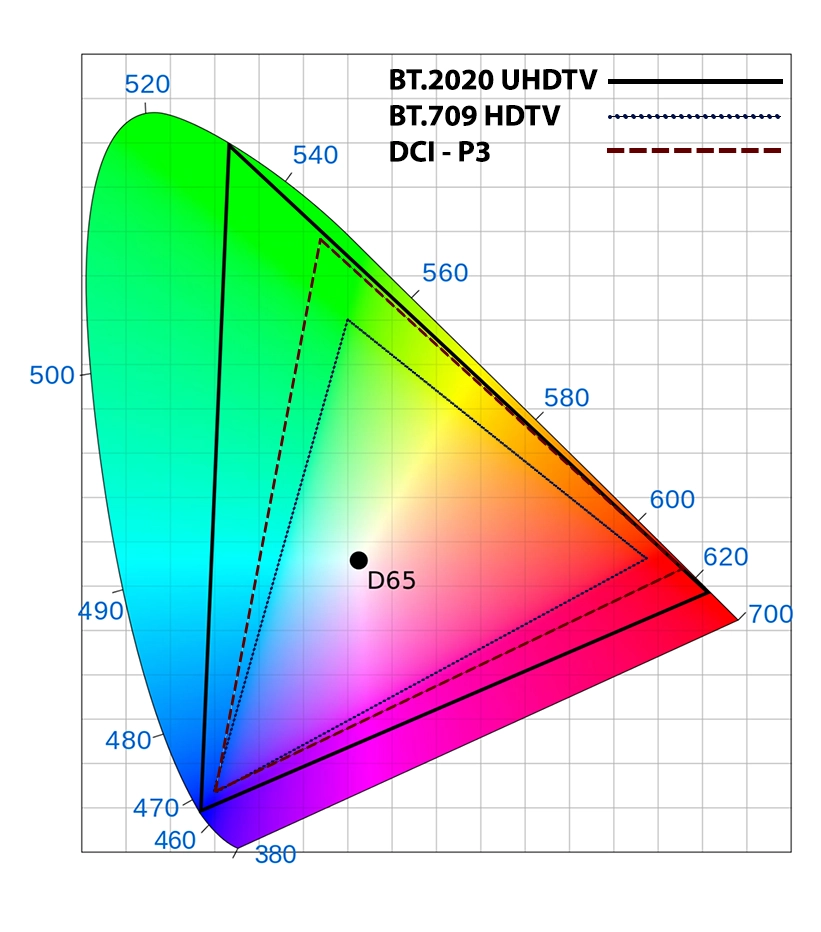
But now, let’s take a look at how different luminosity levels will impact this range. Color ranges for different luminosity levels are placed from the one with the lowest luminosity (on the left) to the highest luminosity (on the right).
Let’s take a look at how luminosity affects color volume. We can see that the color range degrades when luminosity is low (the RGB color space becomes much poorer, in terminal brightness level, it degrades to almost 3 basic colors).
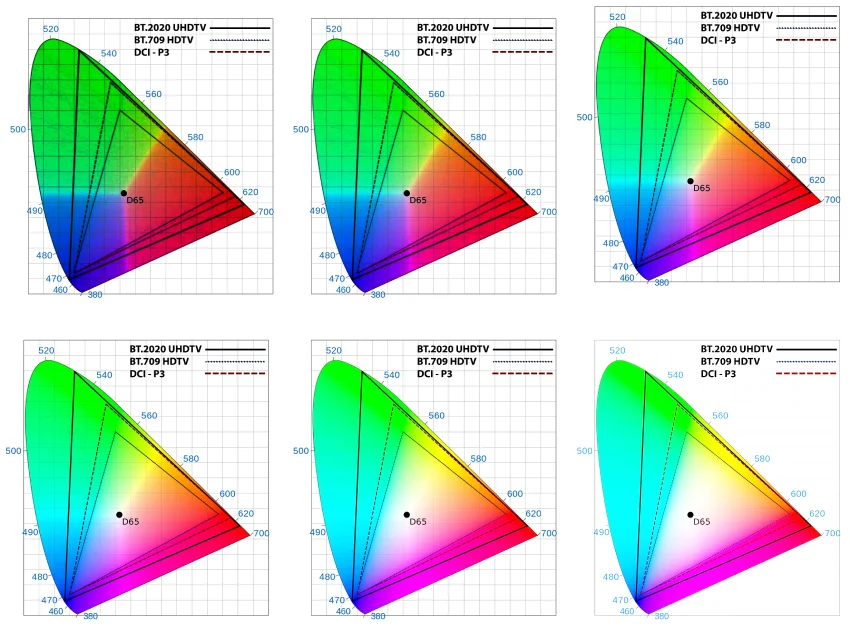
Of course, the image above isn’t precise and accurate (as you can’t get such an array in luminosity difference on a real TV). Still, it gives you the basic understanding – if the TV isn’t supporting high color volume, the colors will degrade at peak and low luminosity levels. Too dim, and the colors fail to pop. Too bright, and they risk being washed out. At high brightness levels, the image becomes bleached, losing its vibrancy and detail. Conversely, at lower levels, the image becomes muddy. A poor TV screen behaves that way.
The color depth
Now, let’s speak about the color depth. Color depth isn’t about the color range; that’s nothing about it. Color depth works like when you’re trying to zoom out a picture. If the size is big enough, zooming out won’t result in quality loss. Or it starts to show individual squares or pixels? Each of those pixels has a color, right? How rich and varied those colors can be is determined by color depth.
Color depth is determined by shades for each color (red, green, and blue), the number of different variants of every color. For an 8-bit image, that’s defined as 2 raised in power to 8, so each color has 256 different shades. 24-bit and 8-bit are the same. as well as 10-bit and 30-bit (the 8-bit or 10-bit color depth is given for one channel, while when we say 24-bit or 30-bit, we’re taking into account all basis channels).
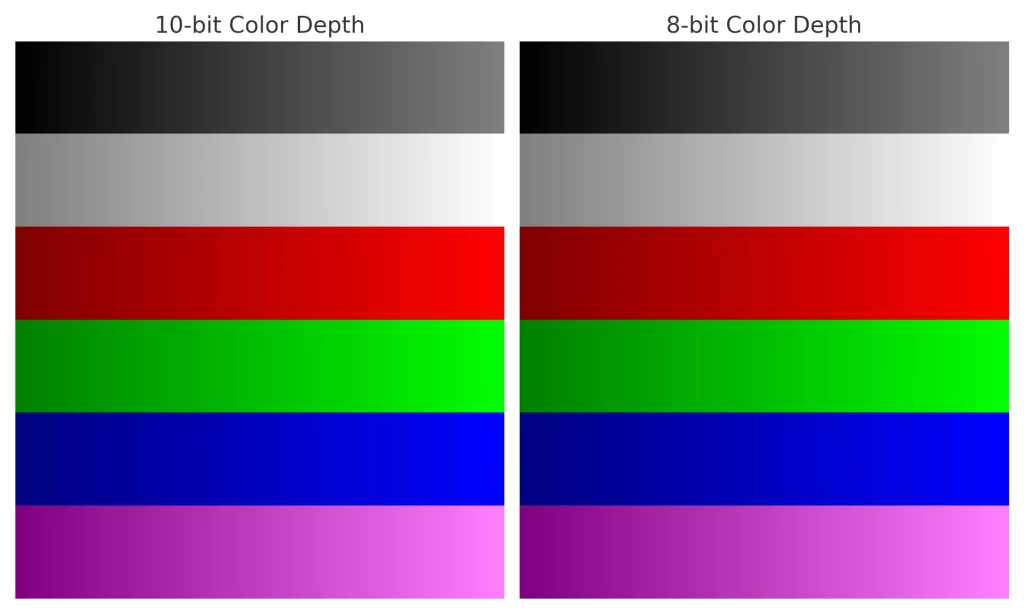
- 8-bit offers 256 shades each of red, green, and blue. If you do the math, that’s 16.7 million colors (256 x 256 x 256).
- 10-bit, on the other hand, catapults this to 1.07 billion colors.
Taking into account that our eye can recognize only around 10 million colors, you are less likely to see the big difference between 8-bit and 10-bit color depth.
But when it comes to the correlation between color depth and color volume, there’s no direct correlation. You can see color volume as the boundaries and the color depth as the inner filling. While higher color depth enhances color with more nuance, it isn’t pushing the boundaries to the new color spaces: color depth ads interim shades.
Contrast
Contrast ratio — the difference between the darkest black and the brightest white a TV can display — adds another layer of complexity. A TV with a high contrast ratio can showcase finer details in shadows and highlights, further enhancing the color volume.
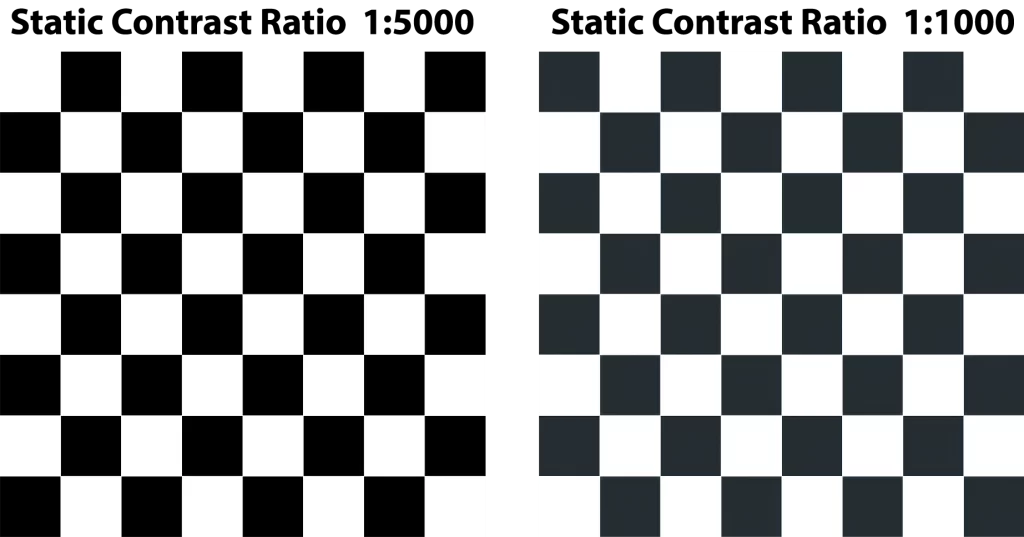
This vast luminance range is the canvas upon which colors are painted. The canvas is limited without adequate contrast, thereby compressing the color volume.
As contrast increases, the range of brightness expands, offering a playground for more colors at various luminance levels. This is particularly crucial for scenes with complex lighting — a sunlit landscape at dawn or the glint of city lights against a twilight sky.
A display with low contrast will seem flat regardless of its color capabilities. Even if it can theoretically cover a wide gamut of colors, without a robust contrast to back it, the scene’s depth and richness fall short.
Imagine an artist with two sets of paint palettes. The first palette has a vast range of colors, but they’re all of a similar, muted tone. The second palette, while having the same colors, offers each shade varying levels of light and darkness.
With its deeper contrast, the second palette allows the artist to create a scene with depth, shadows, highlights, and intricate nuances. The color volume here is fully utilized, thanks to the broader range of contrast.
Color volume and HDR
HDR and color volume a directly related. High Dynamic Range, as its name suggests, offers a wider range between the darkest darks and the brightest brights of an image. Traditional displays suffer from limited dynamic ranges, often failing to render the subtle nuances of a sunrise or the deep shadows of a moonlit night.

To reproduce all of these, HDR TVs should have a wide color volume so they can display the high dynamic range correctly.
As it said, color volume measures whether different colors can be reproduced in various brightness levels, so a TV with a good color volume can show you more details.
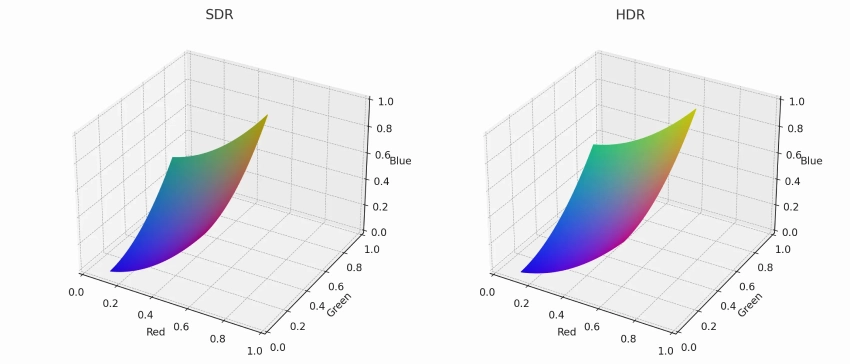
If such a TV supports HDR, and you’re watching HDR content, it will encrypt its metadata and will reproduce more accurate colors. Most HDR-supportive TVs come with wide color volume displays, as without a high-quality display, encrypting HDR metadata and trying to show the content won’t work.
Color volume and different displays: LED, OLED, QLED
While color volume isn’t directly related to the display type, it depends on it. As the color volume is the color space with different luminosity levels, it’s affected by the backlight type and emitting technology the display use.
- LED displays
Traditional LED TVs, which in reality are LCD panels illuminated by LEDs, have long been the workhorse of the display market. In terms of color volume, LED displays can cover a decent range of colors. However, they often struggle with deep blacks and peak brightness due to their backlighting system. The entire panel is illuminated, leading to less precise control of individual areas of brightness. Consequently, their ability to represent colors across varying luminance levels is good but not stellar.
- OLED displays
A leap from LED, OLEDs emit light organically when current passes through them. This unique property enables each pixel to emit its own light, dispensing the need for a backlight. What does this mean for color volume? Dramatic deep blacks, for starters, since individual pixels can be turned off completely. OLEDs also boast a wide color gamut. However, their peak brightness is generally lower than that of QLEDs, which can affect their performance at the upper echelons of luminance. In the spectrum of color volume, they excel in showcasing vivid colors at lower brightness levels.
- QLED displays
QLEDs are essentially LED TVs augmented with quantum dots—nano-sized semiconductor particles that dramatically enhance brightness and color. When it comes to color volume, QLEDs shine brightly. The pixels are made with materials that have better light transmission and color flow selectivity. Such TVs can display an image with a depth of 10 bits. They achieve impressive peaks of brightness, sometimes outperforming OLEDs in this arena. Combined with a broad color gamut, this luminance means they can depict a vast array of colors at both low and high brightness levels. However, since they still utilize a backlighting system, they can’t achieve the infinite contrast and deep blacks of OLEDs.
How to evaluate and test the color volume
To test the color volume, we will need a colorimeter, spectrum light meter, and a way to show pictures with different luminosity on your TV.
As I said, color volume depends on color gamut (color space). There’s no reason to consider Rec. 709 color space, as most modern TVs cover it in full, So there’s a sense to consider DCI P-3 and Rec.2020.
We need to change the TV’s luminosity and measure the available color range on different luminosity levels. That will give us a lot of color ranges for different brightness levels, and their combination would be the color volume. We can express it as the % of color space that TV displays can reproduce on different luminosity levels.
Since 2016, the UHD Alliance has adopted the requirement that premium TVs with UHD resolution must cover at least 90% of the DCI-P3 color space. But that’s a figure for color gamut, not the color volume, so even nowadays, TVs, even if they have similar color ranges, may vary significantly in terms of color volume.
Who checks the DCI-P3 color volume in TVs
The manufacturer can write that the TV supports DCI-P3 (as well as any other color range), but this is not entirely correct. Hence, independent organizations can check whether the product complies with the standard. One such organization is the VDE Institute, which deals with product certification.

